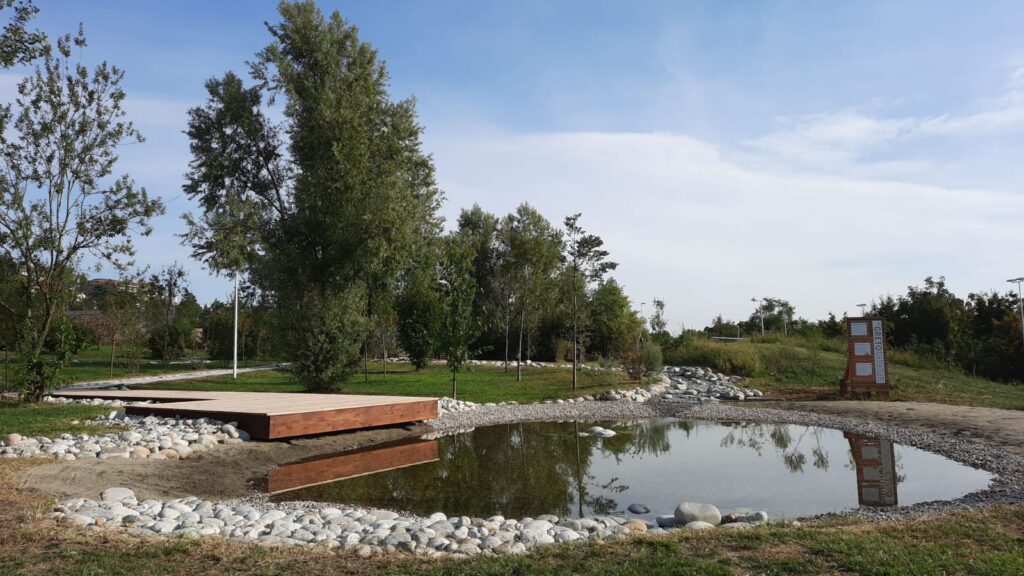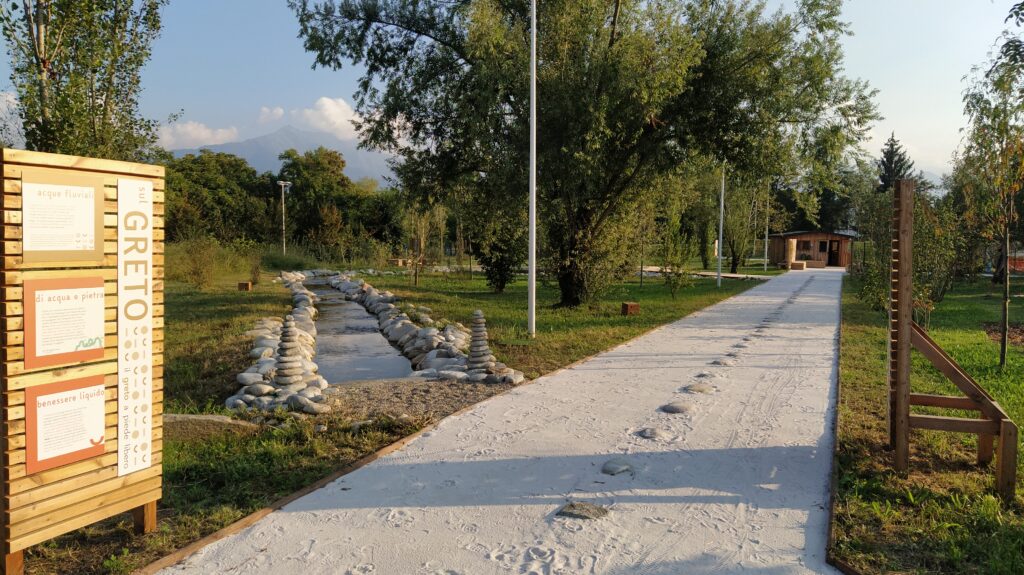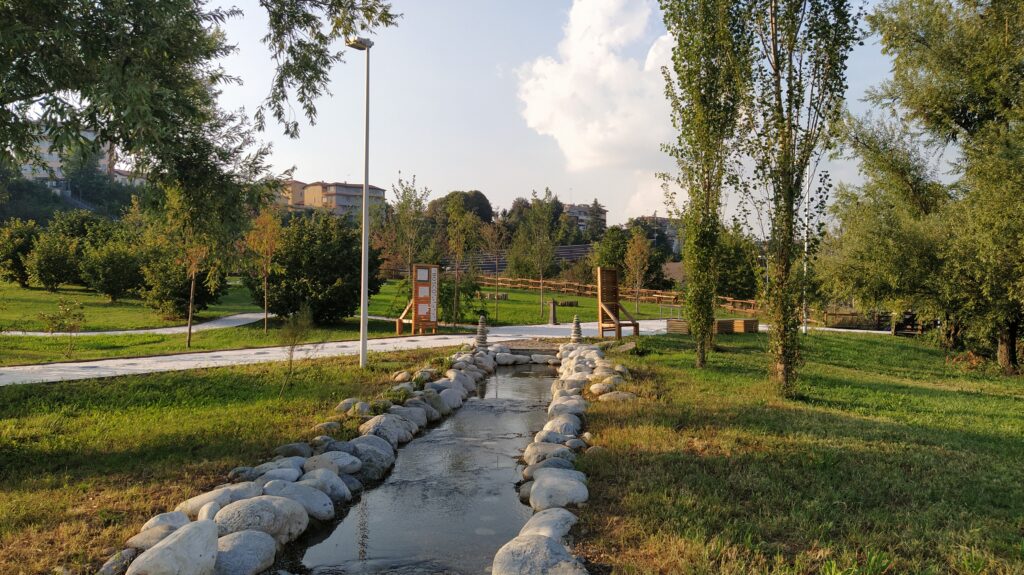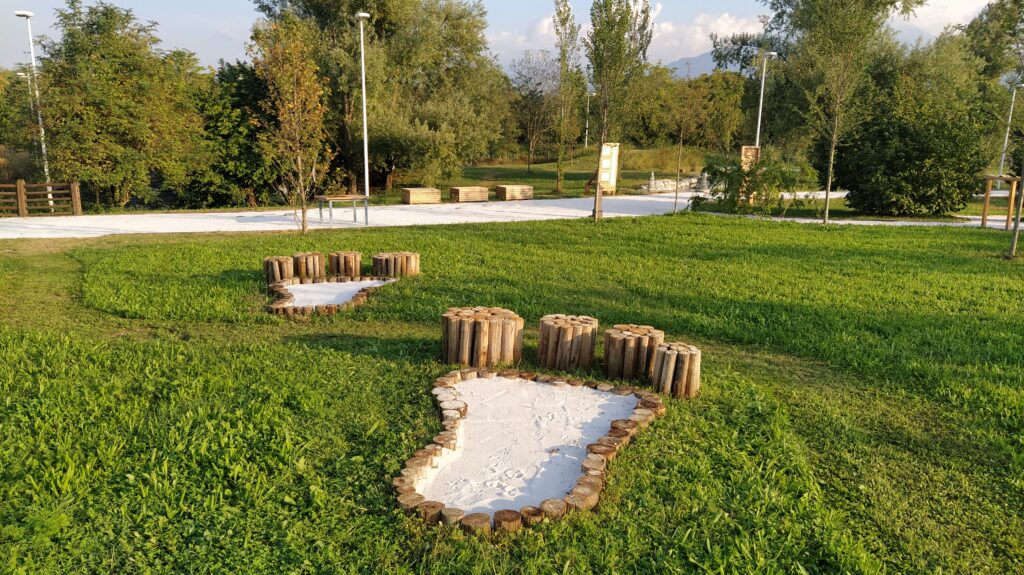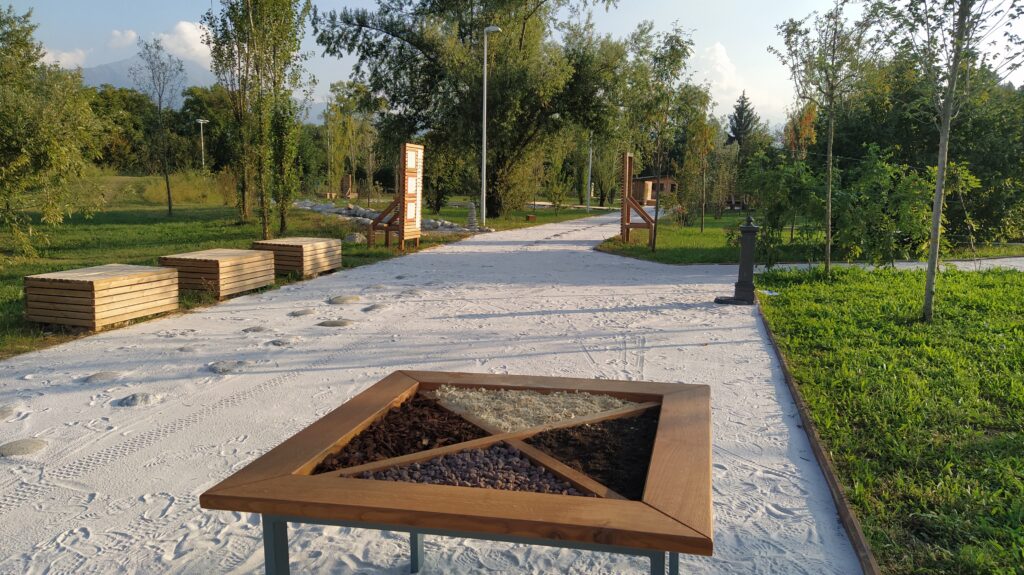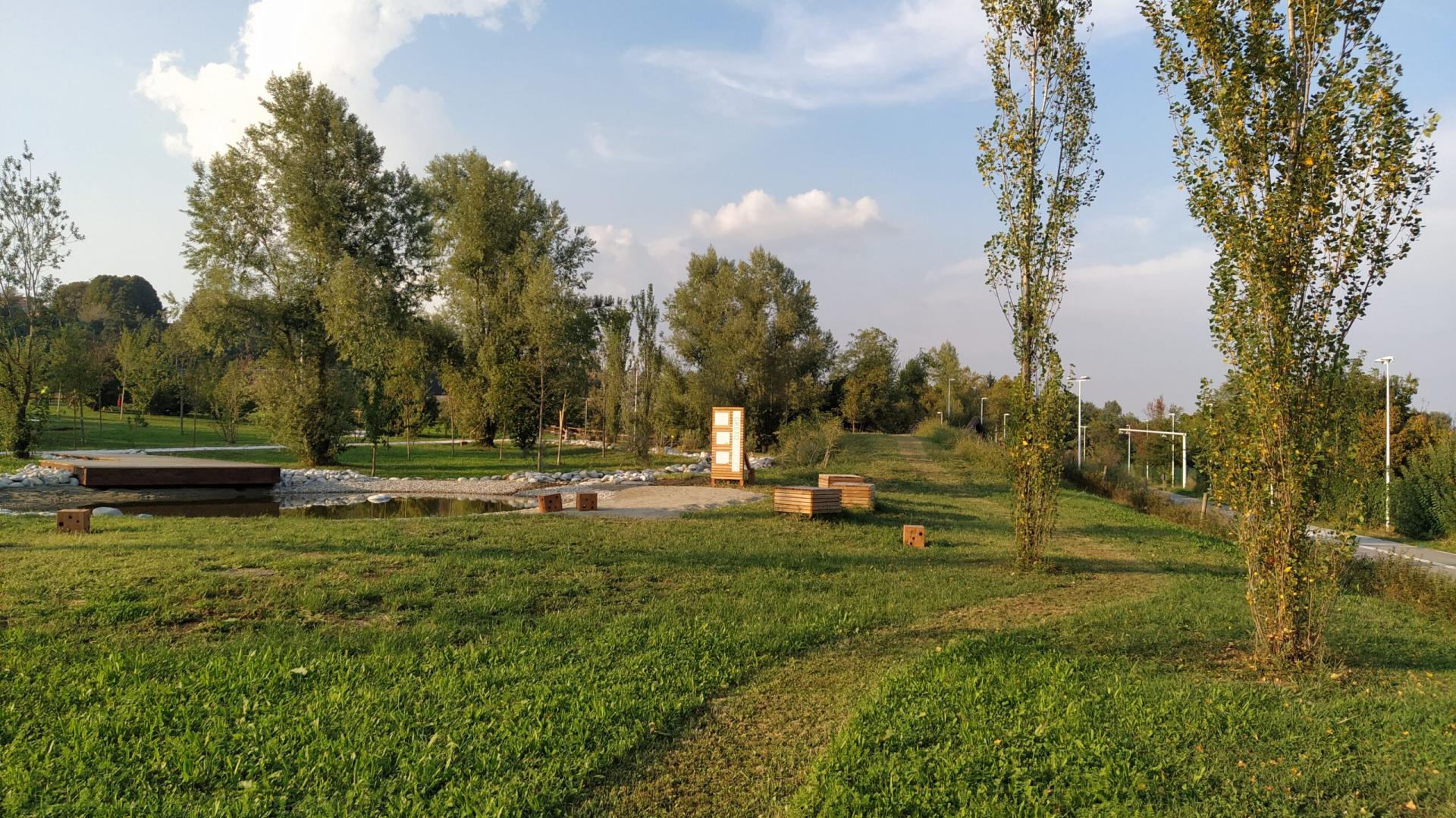F’orma, barefoot – Cuneo
Basic information
Project Title
Full project title
Category
Project Description
A sensory journey within the Gesso and Stura River Park that allows the visitor to develop direct and emotional contact with nature, in particular with water, through paths and landscapes to experience "Naturally, walking with senses"
See: https://youtu.be/wJRZGOgj6Ns
See: https://www.1ax.it/project/forma-il-fiume-a-piede-libero-cuneo/
Project Region
EU Programme or fund
Which funds
Other Funds
Programma di Cooperazione Territoriale Transfrontaliera Interreg V-A Italia-Francia ALCOTRA 2014-2020 Asse 3 “Attrattività del territorio” – obiettivo specifico 3.1 “Patrimonio naturale e culturale”
Progetto n. 1706 “NAT.SENS. Naturalmente, a spasso con i sensi” Azione 4.1 “Progettazione e realizzazione percorsi sensoriali”
Cross-border Territorial Cooperation Program Interreg V-A Italy-France ALCOTRA 2014-2020 Axis 3 "Territorial attractiveness" - specific objective 3.1 "Natural and cultural heritage" Project n. 1706 "NAT.SENS. Of course, walking with the senses "Action 4.1" Design and implementation of sensory paths "
Description of the project
Summary
The general objective of the NAT.SENS project is to "propose an educational, playful, discovery and experiential tourism, which allows overcoming the difficulty of contact with nature by inexperienced people, creating new forms of eco-tourism within everyone's reach ". Starting from this assumption, we asked ourselves the question of how to create a sensory path but also the relationship with the existing infrastructures and with the city of Cuneo.
The solution is simply to bring the river to attention. Therefore, intervene to make the trace of the river "emerge", the suggestion of its imprint, footprint, a concrete testimony of its presence that encloses the essential elements of the river landscape in a confined, destined area to fruition as close as possible to the natural one, but made simpler and more accessible to different types of users.
We wish to approach our goal with barefooting which is an example of direct contact with the elements of nature, a footprint that is a trace, a sign of presence.
But, suggestions aside, the proximity of the river and the River Park to the city makes one necessary broad gaze, which looks at the relationship between the things that happen in this territory and, of consequently, to the possibility of further developing sustainable mobility, also following the vocation of the Gesso and Stura Park. By sustainable mobility, we naturally mean the pedestrian and cycle path, as well as in a park we want to decline in the various possibilities of slow and careful mobility in nature: Hiking, Nordic Walking, Trekking, Cycling, Trail, Mountain Bike and of course Barefooting. This observation confronts us with the objective of thinking of the intervention in question as an opportunity to implement and enrich the sustainable mobility system of the Gesso and Stura Park.
Key objectives for sustainability
The project was born on a former cross-country ski track that had been disused for years for which the administration of the Municipality of Cuneo started in 2017 a process for financing for the realization of a sensory path identified within the Territorial Cross-border Cooperation Program Interreg VA Italy-France ALCOTRA 2014-2020.
The process that led to the creation of the sensory park, therefore, envisaged the redevelopment of an abandoned space to be donated with a new function to the community. The environmental sustainability of the solutions chosen was from the beginning the key to interpreting every choice made within the project. The materials used have been studied to ensure harmony and synergy with the naturalistic context (the park is located close to the Gesso and Stura River Park) identifying in the wood and local stone two of the main materials for furnishings and main characterizing elements. The entire area is completely draining thanks to the use of stabilized ecological flooring. Metal gabions filled with local lithoid material had the function of anchoring the elements that would have provided for the construction of a concrete foundation. The existing vegetation was maintained and protected and new native vegetation, characteristic of the river environments, was planted to recreate suggestions of the surrounding landscape of the nearby River Park within the Park.
The area intended for the realization of the sensory path has a barycentric position, in a strip characterized by the presence, as well as the swimming stadium, of the Environmental Education Center, a Camper area, and the River Gesso Stura. From an environmental and cultural point of view, with the sensory path and the cycle path that runs along its borders, the object of intervention can be considered as the starting point of a sustainable mobility network within the Gesso and Stura Park.
Key objectives for aesthetics and quality
The idea is to rediscover the main landscape components of the river and compose them in such a way as to be able to cross them, touch and know them in the closest possible way to that natural, starting with the discovery of the river area, which often suddenly opens up in front of the eyes, maybe just after the bank or coming out of the thickest vegetation, or it reveals itself through the sound of the water, which is almost deafening from one moment to the next and occupies the sound space completely. The intervention, therefore, aims to recreate a landscape that reveals to the visitor the sequence of surfaces that make up the river landscape.
EXPERIENTIAL ROUTES are with uneven ground, variable slope, and width, which cross the areas offering a freer sensory experience but with some difficulties that will stimulate the proprioception, balance, and sense of orientation of the users. The routes will connect the sensory stations, which will therefore be real crossroads where the visitor can choose, each time, whether to take the easier route or the more bumpy one.
The immersion in the sensory experience will be favored by various interactive devices and games that will favor the use of the five senses in contact with the natural elements of the river landscape. In all paths and sensory stations, users will be able to walk barefoot, stop and feel their sensory experience with the aid of devices that interact with the surrounding space and that help overcome barriers due to physical, visual, auditory cognitive difficulties. An experience of sensory and emotional contact with nature can evoke and awaken channels of perception that are often little used. Furthermore, the playful-educational aspect should not be underestimated, especially aimed at children and favored by the use of interactive games. For children, in fact, the discovery and exploration of a natural environment is always an experience of growth and an opportunity for amazement and involvement.
Key objectives for inclusion
The use and crossing of landscapes take place in compliance with maximum accessibility and without exclusions, designing a series of routes that, through a multi-optional design and multi-sensorial, aims to integrate a methodological approach of a therapeutic-rehabilitative and / or socio-educational, aimed at the treatment and rehabilitation of people with different problems, pathologies or disabilities, to the increase of health and general well-being, favoring in particular: The understanding of space; The orientation; The autonomy; The self-assessment of one's possibilities; The flexibility and personalization of the space; Wellness and comfort; The feeling of security
In this case, the proposal proposes a sensory journey, which is prefigured according to different levels of difficulty, leaving the user - informed and/or followed along the way - the choice based on self-assessment of one's own possibilities. At the meeting points between the different types of routes, or even insignificant points of every single stretch, there are sensory stations, spaces where interaction with the natural environment is maximized thanks to a careful treatment of the surfaces, where to practice a barefooting open to all subjects. adequately prepared work on balance and proprioception that is the basis of the proposed intervention, taking into account the needs of children, the elderly, the disabled, or people who face the sensory path for rehabilitation out-of-hospital healthcare.
The sensory station is an area that can be easy, where there are no jumps in height and difficult passages, and equipped with handrails and rest areas, where users can meet different surfaces such as lawn, shore, and sand.
Results in relation to category
The project that led to the creation of the f'Orma sensory park envisaged a process of co-participation with local actors that led to the redevelopment of urban space in the city of Cuneo, giving a new face to an abandoned space and making the whole complex of activities present in the boundary. The redevelopment of the disused space has led on the one hand to an environmental improvement of the area with a new landscape conformation, planting and construction of wetlands and artificial waterways preceded by a reclamation and disposal of the old cross-country ski slope present operam; on the other hand, he managed to aggregate active citizenship, the administration and the managers of areas dedicated to the neighboring River Park around the idea, improving the social aspect and offering a valid opportunity for working in synergy between the various actors.
How Citizens benefit
The river has always been a guide for those who travel through a territory: it guides, accompanies, sometimes forces us to follow it until we can wade it. And it is a changing landscape, which varies significantly with the seasons, and from year to year, based on climatic conditions, giving rise to a variable equilibrium, modified by the absence and presence, sometimes violence.
The sensory park provided for the active participation of various actors who contributed to making the project complete in all its elements. This has made it possible to guarantee users a space that is attentive to every need, designed for each category, and accessible to all. To do this, several meetings and meetings were organized with the municipal administration, with the cooperative that manages spaces in the River Park, with local designers and carpenters, and with the local health authority. The latter has played a fundamental role in making the park accessible to all and ensuring that the activities to be carried out within the park are not only accessible to all but are a stimulus for the development of motor, perceptual and cognitive skills. In fact, in the design of spaces and elements, the directives of experts in the field of proprioception and motor skills were followed. The park managers (which inauguration is scheduled for next June 2) are very satisfied with the final result and have collected consensus and participation from the citizens.
Innovative character
The f’Orma project has the peculiarity of being a park that can be entirely covered on bare feet and completely designed to experience a sensory experience in a context that recalls the naturalness of the surrounding river landscapes. The external landscape is projected in miniature within the spaces and, through a series of paths, it is possible to follow the transformations that are created along with the courses of a river. This theme was developed through an animated narrative (with the help of local designers) to bring children closer to fun and playful teaching. Inside the park, it is also possible to measure one's motor and perceptive skills through dedicated signs to help each activity present. The park is aimed at adults and children who want to spend a day different from the ordinary trying unusual experiences such as walking barefoot on a bed of leaves rather than inside a pond.
This is also why it is interesting speaking of proprioception and equilibrium in a reality like that of a river park: we are talking about bringing everyone, children, the elderly, people with motor disabilities closer to a guide that is not always there predictable, a territory that is not always easy, a context that can be uncomfortable.

